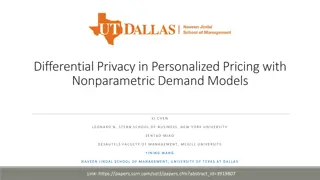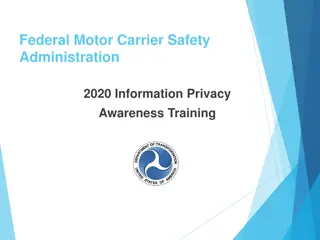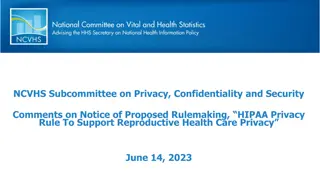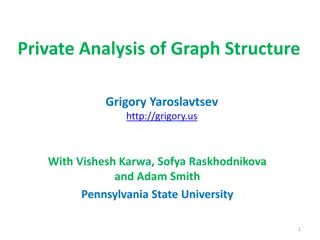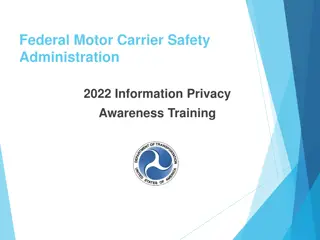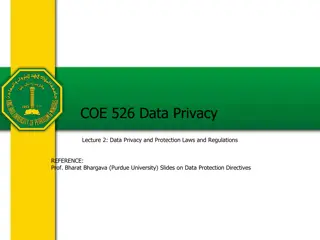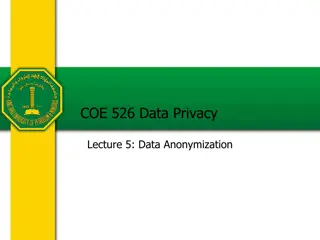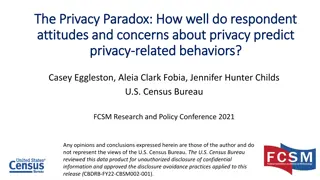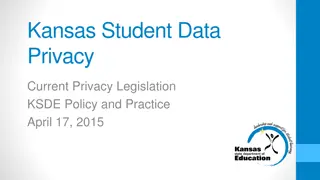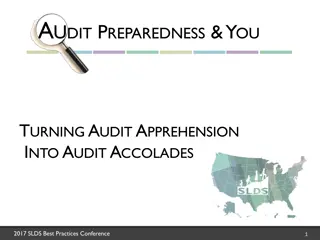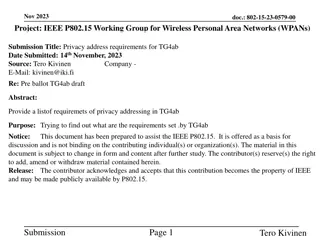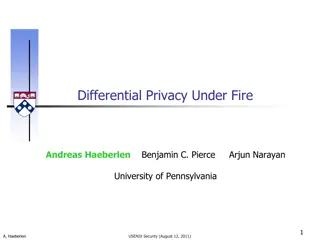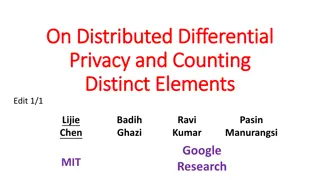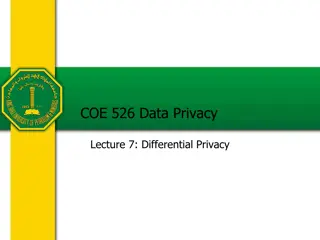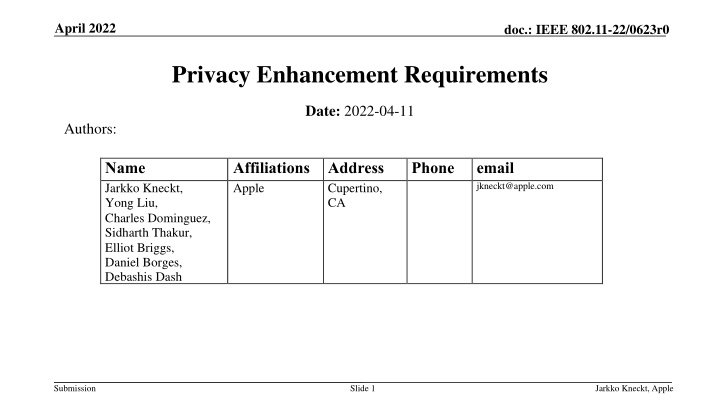
Enhanced Privacy Requirements for IEEE 802.11-22 Standard
Explore the proposal for privacy enhancements in IEEE 802.11-22 standard, focusing on Client Privacy Enhancements (CPE) and BSS Privacy Enhancements (BPE). The submission outlines new requirements for improved privacy features and their optional nature within the standard. Terminology and detailed features of CPE and BPE are discussed to prevent identification and tracking of individual clients and entire BSS.
Download Presentation

Please find below an Image/Link to download the presentation.
The content on the website is provided AS IS for your information and personal use only. It may not be sold, licensed, or shared on other websites without obtaining consent from the author. If you encounter any issues during the download, it is possible that the publisher has removed the file from their server.
You are allowed to download the files provided on this website for personal or commercial use, subject to the condition that they are used lawfully. All files are the property of their respective owners.
The content on the website is provided AS IS for your information and personal use only. It may not be sold, licensed, or shared on other websites without obtaining consent from the author.
E N D
Presentation Transcript
April 2022 doc.: IEEE 802.11-22/0623r0 Privacy Enhancement Requirements Date: 2022-04-11 Authors: Name Jarkko Kneckt, Yong Liu, Charles Dominguez, Sidharth Thakur, Elliot Briggs, Daniel Borges, Debashis Dash Affiliations Address Apple Phone email jkneckt@apple.com Cupertino, CA Submission Slide 1 Jarkko Kneckt, Apple
April 2022 doc.: IEEE 802.11-22/0623r0 Abstract Proposal: We propose consider 11bi as two sets of features Client Privacy Enhancements (CPE) preventing identification & tracking of the Client BSS Privacy Enhancements (BPE) preventing identification & tracking of the whole BSS (AP+Clients). Extends CPE The split to the CPE and BPE devices follows the submission 22-107r2 New and modified requirements are proposed that follow the same systematic classification Some of the BPE requirements from 11/107r2 are modified to provide better privacy for BPE AP and BPE STA This submission provides requirements to all technical issues Our approach is that the all 11bi features are optional and other organizations can decide when they are mandatory. Submission Slide 2 Jarkko Kneckt, Apple
April 2022 doc.: IEEE 802.11-22/0623r0 Terminology (for this presentation) [22/107r2] Abbreviation Client AP PE CPE BPE CPE Client (AP) BPE Client (AP) Legacy Client (AP) OTA MAC Address DS MAC Address Meaning non-AP STA or (non-AP MLD with affiliated STAs) AP or (AP MLD with affiliated APs) Privacy Enhancements = Features specified by 11bi Client Privacy Enhancements BSS Privacy Enhancements CPE-capable Client (AP) BPE-capable Client (AP) non-11bi Client (AP) MAC Address used in TA and RA MAC Address used to route messages in the DS Submission Slide 3 Jarkko Kneckt, Apple
April 2022 doc.: IEEE 802.11-22/0623r0 Two set of PE Features [22/107r2] Client PE (CPE) features Prevents id and tracking of individual CPE Clients when used with CPE AP. (Mostly) coordinated/managed by CPE Client. Can a BSS with Client PE features also support seamless legacy connections? YES BSS PE (BPE) features AP Privacy Use cases. Builds on & extends CPE features Prevents id & tracking of entire BSS (BPE AP + associated BPE Clients). Coordinated/managed by BPE AP Can a BSS with BSS PE features also support seamless legacy connections? No AP privacy enhancements prevent backward compatibility Submission Slide 4 Jarkko Kneckt, Apple
April 2022 doc.: IEEE 802.11-22/0623r0 CPE and BPE Feature Summary [22/107r2] Client PE (CPE) Feature ID Client PE (CPE) Features CPE-A SAE password ID & PMKID obfuscation (not discussed) CPE-B Client Fingerprinting resistance Minimal IE in Probe Request. (Re)Assoc Request/Response encrypted CPE Clients receive and transmit protected management frames CPE-C Client OTA MAC Address (TA/RA) randomization Simultaneously change AID, SN & PN (both directions), CPE STA changes scrambler seed when it changes OTA addresses CPE-D Private Client DS MAC Addresses CPE-E SA/DA Obfuscation CPE-F Client sensing and ranging privacy CPE-G Other MAC Header fields and A-Control field obfuscation / encryption TGbi Proposed Issues [1] I1: Protecting Password Identifiers I2: Avoid Element Fingerprint I3: STA MAC address persistence within an ESS I4: Tracking SA & DA OTA I5: Protecting authentication identifiers and key identifiers I6: Mobile AP Privacy I7: Protecting behavioral fingerprinting while associated I8: PHY/RF related privacy BSS PE (BPE) Issue I1, I5 Feature ID BSS PE (BPE) Feature BPE-A SSID, SAE password ID & PMK obfuscation (not discussed) BPE-B AP Fingerprinting resistance Minimal IE in Beacon and Probe Response. Management frames encryption, discovery frames obfuscation TBTT randomization Easy and fast BPE AP discovery (Re)Assoc Request/Response encrypted BPE-C BSSID (TA/RA) Randomization Simultaneously change AID, SN & PN (both directions) Group Addressed frames (TA/RA) randomization BPE-D Private AP DS MAC Address (same as CPE-D) BPE-E SA/DA hidden OTA BPE-F AP and client sensing and ranging privacy Issue I6 I2, I6 I2 I3 I6, I7 I3 I4 I8, I2 I7 I6 I6 I2, I6, I8 I7 BPE-G Other MAC Header fields and A-Control field obfuscation / encryption (Same as CPE-G) This submission: BPE/CPE-F and BPE/CPE-G requirements are added BPE-B and BPE-C requirements are modified Submission Slide 5 Jarkko Kneckt, Apple
April 2022 doc.: IEEE 802.11-22/0623r0 NEW PROPOSED CLIENT PE FEATURE REQUIREMENTS Submission Slide 6 Jarkko Kneckt, Apple
April 2022 doc.: IEEE 802.11-22/0623r0 CPE-B: Client Fingerprinting See Issue 2) Avoid Element Fingerprint Background: Elements are transmitted in the clear OTA in unprotected management frames. Risk: Eavesdropper observes Elements from the unprotected management frames to develop an Element Fingerprint which can be used to identify or track a Client. Goal of countermeasure: Allow the best possible privacy for associated Clients by using protected management frames. New Requirement (to be added to 21/1848): CPE-B: Unicast management frames between CPE AP and associated CPE Client are encrypted. Submission Slide 7 Jarkko Kneckt, Apple
April 2022 doc.: IEEE 802.11-22/0623r0 CPE-C: Client OTA MAC Address Randomization (2/2) Related to Issue 3) STA MAC address persistence within an ESS Background: Scrambler Seed is derived from previously transmitted frames and sent in the clear OTA. Risk: Eavesdroppers can track Client by observing Scrambler Seed. Goal of countermeasure: Avoid STA tracking through Scrambler Seed. New Requirement (to be added to 21/1848): CPE-C: 11bi shall define a mechanism for a CPE Client to reset the Scrambler Seed when its MAC address is changed in Associate STA State 4, without any loss of connection. Submission Slide 8 Jarkko Kneckt, Apple
April 2022 doc.: IEEE 802.11-22/0623r0 CPE-F: Sensing And Ranging Privacy (1/2) See issue 2) Avoid Element Fingerprint, 7) Protecting behavioral identification Background: Sensing STA should not be identifiable or trackable Risk: The STA that performs sensing is identifiable and trackable Goal of the countermeasure: Clients OTA address, SN, PN used for tracking are changeable and cannot be combined with data transmission information New Requirements (to be added to 21/1848): CPE-F-1: 11bi shall define a mechanism for CPE APs and CPE Clients and to use different MAC addresses for ongoing sensing measurements and data transmissions. CPE-F-2: 11bi shall define a mechanism for CPE APs and CPE Clients to apply MAC address and other MAC Header fields change mechanisms for ongoing sensing measurements. I.e., the CPE-C requirements apply for ongoing sensing measurements. Submission Slide 9 Jarkko Kneckt, Apple
April 2022 doc.: IEEE 802.11-22/0623r0 CPE-F: Sensing And Ranging Privacy (2/2) See issue 8) PHY/RF related privacy Background: Beamforming and beamforming results are sent in the clear OTA Risk: This reveals identifiable characteristics of the device that may be used to track the device Goal of the countermeasure: Encrypt or obfuscate the characteristic parameters of the STA. New Requirement (to be added to 21/1848): CPE-F-3: 11bi shall define a mechanism to protect transmitted sensing measurement frames against eavesdropper sensing estimations, i.e., the frames are protected from the eavesdroppers to perform sensing or ranging from the received frames. Submission Slide 10 Jarkko Kneckt, Apple
April 2022 doc.: IEEE 802.11-22/0623r0 CPE-G: Other MAC Header fields and A-Control field obfuscation / encryption See issue 7) Protecting behavioral fingerprinting while associated Background: MAC Header fields are currently sent in the clear OTA Risk: This reveals identifiable characteristics of the device that may be used to track the device Goal of the countermeasure: Hide or obfuscate the characteristic parameters of the STA New Requirements (to be added to 21/1848): CPE-G-1: 11bi shall define a mechanism for a CPE Client and CPE AP to obfuscate the transmitted TID to an uncorrelated new value on downlink and uplink to new values in Associate STA State 4, without any loss of connection. CPE-G-2: 11bi shall define a mechanism for CPE Clients and CPE APs to encrypt the contents of power save related MAC Header fields (PM, EOSP, MD). CPE-G-3: 11bi shall define a mechanism for CPE Clients and CPE APs to encrypt the +HTC field and the HT Control field. CPE-G-4: 11bi shall define a mechanism for CPE Clients and CPE APs to encrypt the Retry bit. Submission Slide 11 Jarkko Kneckt, Apple
April 2022 doc.: IEEE 802.11-22/0623r0 Summary of all CPE Requirements (1/2) Requirement CPE-A: SAE Password ID and PMKID obfuscation CPE-A-1 11bi shall define a mechanism to prevent an eavesdropper distinguishing whether authentication exchanges between CPE Clients and CPE AP use identical SAE credentials or distinct SAE credentials (where a CPE AP supports multiple SAE credentials). CPE-A-2 11bi shall define a mechanism to prevent an eavesdropper distinguishing whether reassociation exchanges between CPE Clients and CPE APs use identical PMK or distinct PMK. CPE-B: Client Fingerprinting resistance CPE-B-1 11bi shall define a minimal set of Elements for transmission by a CPE Client in a probe request prior to authentication. CPE-B-2 11bi shall define a mechanism for a CPE Client and CPE AP to establish keys from an Authentication exchange which can then be used to protect the (Re)Association Request/Response. CPE-B-3 11bi shall define a mechanism for a CPE Client and CPE AP toprotect the (Re)Association Request/Response. CPE-B-4 CPE-B-4: Unicast management frames between CPE AP and associated CPE Client are encrypted. CPE-C: Client OTA MAC Address randomization CPE-C-1 11bi shall define a mechanism for a CPE Client to change its own OTA MAC Address when reassociating from a CPE AP to another CPE AP. CPE-C-2 11bi shall define a mechanism for a CPE Client to initiate changingits own OTA MAC Address used with a CPE AP in Associate STA State 4 without any loss of connection. CPE-C-3 11bi shall define a mechanism for a CPE AP to initiate changing the OTA MAC Addresses of all associated CPE Client s in the BSS (those CPE Clients in Associate STA State 4) simultaneously without any loss of connection. CPE-C-4 11bi shall define a mechanism for a CPE Client and CPE AP to change the transmitted SN to an uncorrelated new value on downlink and uplink to new values in Associate STA State 4, without any loss of connection. CPE-C-5 11bi shall define a mechanism for a CPE Client and CPE AP to change the transmitted PN to an uncorrelated new value on downlink and uplink to new values in Associate STA State 4, without any loss of connection. CPE-C-6 11bi shall define a mechanism for a CPE Client and CPE AP to change the CPE Client s AID to an uncorrelated new value in Associate STA State 4, without any loss of connection. CPE-C-7 11bi shall define a mechanism for a CPE Client to reset the Scrambler when its MAC address is changed in Associate STA State 4, without any loss of connection. Req ID Issue I1, I5 I2 I3 Requirements proposed by this submission are underlined and in blue. Submission Slide 12 Jarkko Kneckt, Apple
April 2022 doc.: IEEE 802.11-22/0623r0 Summary of all CPE Requirements (2/2) Req ID CPE-D: Private DS MAC Addresses CPE-D-1 11bi shall define a mechanism for a CPE Client and CPE AP to establish the CPE Client s DS MAC Address without the CPE Client s DS MAC Address being transmitted in the clear. CPE-E: SA/DA Obfuscation CPE-E-1 11bi shall define a mechanism for CPE Clients and CPE APs to transmit and receive the CPE Client s DS MAC Address in SA and DA in protected form on both the downlink and uplink. CPE-E-2 11bi shall define a mechanism for CPE Clients and CPE APs to transmit and receive other DS MAC Addresses in SA and DA in protected form on both the downlink and uplink. CPE-F: Sensing And Ranging Privacy CPE-F-1 11bi shall define a mechanism for CPE APs and CPE Clients to use different MAC addresses for ongoing sensing measurements and data transmissions. CPE-F-2 11bi shall define a mechanism for CPE APs and CPE Clients to apply MAC address and other MAC Header fields change mechanisms for ongoing sensing measurements. I.e., the CPE-C requirements apply for ongoing sensing measurements. CPE-F-3 11bi shall define a mechanism to protect transmitted sensing measurement frames against eavesdropper sensing estimations, i.e., the frames are protected from the eavesdroppers to perform sensing or ranging from the received frames. CPE-G: Other MAC Header fields and A-Control field Obfuscation / Encryption CPE-G-1 11bi shall define a mechanism for a CPE Client and CPE AP to obfuscate the transmitted TID to an uncorrelated new value on downlink and uplink to new values in Associate STA State 4, without any loss of connection. CPE-G-2 11bi shall define a mechanism for CPE Clients and CPE APs to encrypt power save related MAC Header fields (PM, EOSP, MD). CPE-G-3 11bi shall define a mechanism for CPE Clients and CPE APs to encrypt the +HTC field and the HT Control field. CPE-G-4 11bi shall define a mechanism for CPE Clients and CPE APs to encrypt the Retry bit. Requirement Issue I3 I4 I2, I8 I7 Requirements proposed by this submission are underlined and in blue. Submission Slide 13 Jarkko Kneckt, Apple
April 2022 doc.: IEEE 802.11-22/0623r0 NEW AND MODIFIED BSS PE FEATURE REQUIREMENTS Submission Slide 14 Jarkko Kneckt, Apple
April 2022 doc.: IEEE 802.11-22/0623r0 BPE-B: AP Fingerprinting See Issue 2) Avoid Element Fingerprint & Issue 6) Mobile AP privacy Background: Elements are transmitted unprotected in Beacon, Probe Response and other management frames. Risk: Eavesdropper observes Elements to develop an Element Fingerprint which can be used to identify or track an AP. Goal of countermeasure: BPE AP encrypts its elements and minimizes leaked information. It is good start to minimize the number of transmitted elements, but even few unprotected elements enable AP tracking. New Requirements (to be added to 21/1848): BPE-B-1: 11bi shall define a mechanism for the BPE AP transmit encrypted management frames. Discovery frames and ranging/sensing results frames may be obfuscated. BPE-B-2: 11bi shall define a mechanism to randomize Beacon transmission times. BPE-B-3: 11bi shall define a mechanism for the BPE Client and BPE AP to fast active scan available PBE APs in the channel. BPE-B-4: 11bi shall define new RNR element to include obfuscated BPE AP identifiers for out-of- the-band discovery of the BPE AP. BPE-B-5: 11bi shall define a mechanism to obfuscate affiliated BPE APs parameters so that eavesdroppers cannot determine that BPE APs belong to the same AP MLD. Submission Slide 15 Jarkko Kneckt, Apple
April 2022 doc.: IEEE 802.11-22/0623r0 BPE-C: BSSID and Group Frames Randomization (1/2) See Issue 6) Mobile AP privacy Background: BSSID (AP s OTA MAC Address) is static. Associated Clients OTA MAC Addresses might change infrequently. Risk: Eavesdropper can use the BSSID to track the BSS (both the AP and the Client s associated to the AP). Eavesdropper can also use OTAMAC address of associated Clients to track the BSS. Goal of countermeasure: allow randomization of the AP s OTA MAC Address with and without associated Clients. Allow AP to initialize randomization of the associated Clients OTA MAC Addresses Old Requirements [22/107r2] (no changes to 21/1848): BPE-C-1: A BPE AP may change its BSSID while there are no Clients associated. BPE-C-2: 11bi shall define a mechanism for a BPE AP to facilitate changing its BSSID while there are Clients associated, without disrupting the connectivity from the Clients. The following existing requirement also addresses this feature CPE-C-3: 11bi shall define a mechanism for a CPE AP to initiate seamlessly changing the OTA MAC Addresses of all associated CPE in the BSS Client s (those CPE Clients in Associate STA State 4) simultaneously without any loss of connection Submission Slide 16 Jarkko Kneckt, Apple
April 2022 doc.: IEEE 802.11-22/0623r0 BPE-C: BSSID and Group Frames Randomization (2/2) See Issue 6) Mobile AP privacy Background: Associates clients unicast addresses changes should occur at random times to complicated BSS Tracking. The group addressed frames addresses should be obfuscated to protect AP privacy Risk: Eavesdropper can detect the new addresses if all addresses are transmitted at the same time. Eavesdropper can also use The group addressed frames addresses to track the BSS Goal of countermeasure: Improve unicast and group addressed frames address randomization. Allow AP to initialize randomization of the group frames OTA MAC Addresses New Requirements (to be added to 21/1848): BPE-C-3: 11bi shall define a mechanism to for BPE AP and BPE Client to change the OTA MAC addresses, SN and PN they use for unicast transmissions at STA specific schedule without any loss of connection. BPE-C-4: 11bi shall define a mechanism to for BPE AP to obfuscate the RA, SN and PN of the group frames to avoid BPE AP tracking without any loss of connection. BPE-C-5: BPE Client and BPE AP shall reset the Scrambler Seed on individual and group addressed frames when MAC address is changed without any loss of connection. Submission Slide 17 Jarkko Kneckt, Apple
April 2022 doc.: IEEE 802.11-22/0623r0 BPE-F: Sensing And Ranging Privacy See Issue 2), 6) 7) and 8) Background: Sensing and ranging operations may enable AP and STA tracking. Risk: This reveals measurement reports and MAC Addresses information of the AP and Clients, allowing them to be identified or tracked. Goal of countermeasure: Obfuscate AP and STA parameters and encrypt management frames. The BPE AP and BPE STA use protected management frames New Requirements (to be added to 21/1848): BPE-F-111bi shall define a mechanism for BPE APs and BPE Clients to use different MAC addresses for ongoing sensing measurements and data transmissions. BPE-F-2: 11bi shall define a mechanism for BPE AP and BPE Clients to apply MAC address and other MAC Header fields change mechanisms for ongoing sensing measurements and data transmissions. I.e., the BPE-C requirements apply for ongoing sensing measurements. BPE-F-3: 11bi shall define a mechanism to protect transmitted sensing measurement frames against eavesdropper sensing estimations, i.e., the frames are protected from the eavesdroppers to perform sensing or ranging from the received frames. Slide 18 Submission Jarkko Kneckt, Apple
April 2022 doc.: IEEE 802.11-22/0623r0 BPE-G: Other MAC Header fields and A-Control field privacy enhancements See issue 7) Protecting behavioral fingerprinting while associated Background: MAC Header fields are currently sent in the clear OTA Risk: This reveals identifiable characteristics of the device that may be used to track the device Goal of the countermeasure: Hide or obfuscate the characteristic parameters of the STA and AP. E.g. The existing MAC Headers are zeroed and the payload is carried in the encrypted payload New Requirements (to be added to 21/1848): BPE-G-1: 11bi shall define a mechanism for a BPE Client and BPE AP to obfuscate the transmitted TID to an uncorrelated new value on individually and group addressed frames to new values in Associate STA State 4, without any loss of connection. BPE-G-2: 11bi shall define a mechanism for BPE Clients and BPE APs to encrypt the contents of power save related MAC Header fields (PM, EOSP, MD). BPE-G-3: 11bi shall define a mechanism for BPE Clients and BPE APs to encrypt the +HTC field and the HT Control field. BPE-G-4: 11bi shall define a mechanism for BPE Clients and BPE APs to encrypt the Retry bit. Submission Slide 19 Jarkko Kneckt, Apple
April 2022 doc.: IEEE 802.11-22/0623r0 BPE Requirements Summary (1/3) Req ID Requirement Issue BPE A: SSID, SAE Password ID & PMK obfuscation BPE-A-1 11bi shall define a mechanism for a BPE Client to determine which of the BPE Client s configured networks a BPE AP belongs to (if any), while providing some mitigation against an eavesdropper easily identifying the ESS of the BPE AP. BPE B: AP Fingerprinting resistance BPE-B-1 11bi shall define a mechanism for the BPE AP to transmit encrypted management frames.Discovery frames and ranging/sensing results may be obfuscated. BPE-B-2 11bi shall define a mechanism to randomize Beacon transmission times. BPE-B-3 11bi shall define a mechanism for the BPE Client and BPE AP to fast active and passive scan available PBE APs in the channel. BPE-B-4 11bi shall define new RNR element to include obfuscated BPE AP identifiers for out-of-the-band discovery of the BPE AP. BPE-B-5 11bi shall define a mechanism to obfuscate affiliated BPE APs parameters so that eavesdropping STAs cannot determine that they belong to the same AP MLD. I6 Also addressed by Requirements CPE-A-1 and CPE-A-2 I2, I6 Requirements proposed by this submission are underlined and in blue. Submission Slide 20 Jarkko Kneckt, Apple
April 2022 doc.: IEEE 802.11-22/0623r0 BPE Requirements Summary (2/3) Req ID BPE C: BSSID and group frames randomization BPE-C-1 BPE AP may change its BSSID while there are no Clients associated. BPE-C-2 11bi shall define a mechanism for a BPE AP to facilitate changing its BSSID while there are Clients associated, without disrupting the connectivity from the Clients. Requirement Issue I6, I7 BPE-C-3 11bi shall define a mechanism to for BPE AP and BPE Client to change the OTA MAC addresses, SN and PN they use for unicast transmissions at STA specific schedule. BPE-C-4 11bi shall define a mechanism to for BPE AP to obfuscate the RA, SN and PN of the group frames to avoid BPE AP tracking. BPE-C-5 BPE Client and BPE AP shall reset the Scrambler Seed on individual and group addressed frames when MAC address is changed. BPE D: AP Private DS MAC Address Also addressed by Requirements CPE-D I6 BPE-D-1 11bi shall define a mechanism for a BPE Client and BPE AP to establish the BPE AP s DS MAC Address without the CPE AP s DS MAC Address being transmitted in the clear. This will likely be the same mechanism as used in Req CPE-D-1 BPE-E: SA/DA Obfuscation: Also addressed by Requirements CPE-E-1, CPE-E-2 I6 Copy of CPE-E-1: 11bi shall define a mechanism for CPE Clients and CPE APs to transmit and receive the CPE Client s DS MAC Address in SA and DA in protected form on both the downlink and uplink. Copy of CPE-E-2: 11bi shall define a mechanism for CPE Clients and CPE APs to transmit and receive other DS MAC Addresses in SA and DA in protected form on both the downlink and uplink. Requirements proposed by this submission are underlined and in blue. BPE-E-1 BPE-E-2 Submission Slide 21 Jarkko Kneckt, Apple
April 2022 doc.: IEEE 802.11-22/0623r0 BPE Requirements Summary (3/3) Req ID Requirement Issue BPE F: Sensing and Ranging Privacy Also addressed by Requirements CPE-F I2, I6, I7, I8 BPE-F-1 BPE-F-111bi shall define a mechanism for BPE APs and BPE Clients to use different MAC addresses for ongoing sensing measurements and data transmissions. 11bi shall define a mechanism for BPE AP and BPE Clients to apply MAC address and other MAC Header fields change mechanisms for ongoing sensing measurements and data transmissions. I.e., the BPE-C requirements apply for ongoing sensing measurements. 11bi shall define a mechanism to protect transmitted sensing measurement frames against eavesdropper sensing estimations, i.e., the frames are protected from the eavesdroppers to perform sensing or ranging from the received frames. BPE-G: Other MAC Header fields and A-Control field obfuscation/ encryption Also addressed by Requirements CPE-G BPE-F-2 BPE-F-3 I7 BPE-G-1 11bi shall define a mechanism for a BPE Client and BPE AP to obfuscate the transmitted TID to an uncorrelated new value in Associate STA in State 4, without any loss of connection. 11bi shall define a mechanism for BPE Clients and BPE APs to encrypt power save related MAC Header fields (PM, EOSP, MD). BPE-G-2 BPE-G-3 11bi shall define a mechanism for BPE Clients and BPE APs to encrypt the +HTC field and the HT Control field. BPE-G-4 11bi shall define a mechanism for BPE Clients and BPE APs to encrypt the Retry bit. Requirements proposed by this submission are underlined and in blue. Submission Slide 22 Jarkko Kneckt, Apple
April 2022 doc.: IEEE 802.11-22/0623r0 Summary The proposal are proposed to follow the same two sets as in [22-107]: Client Privacy Enhancements (CPE) features BSS Privacy Enhancements (BPE) features The proposed CPE and BPE features address all issues from 1) to 8) Focus on BPE AP privacy and discovery Two new requirement types are added to CPE and BPE Ranging and ongoing sensing measurement privacy enhancements MAC address fields privacy protection Submission Slide 23 Jarkko Kneckt, Apple
April 2022 doc.: IEEE 802.11-22/0623r0 References [1] 11-22-107r2 Initial Privacy Enhancement Requirements [2] 11-21-641r7 Proposed Issues [3] 11-21-1848r6 Requirements Document [4] 11-21-0109r1 Proposed 11bi Requirements Submission Slide 24 Jarkko Kneckt, Apple


